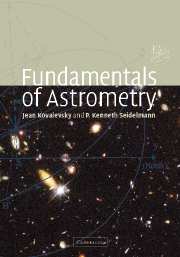Book contents
- Frontmatter
- Contents
- Preface
- List of abbreviations
- 1 Introduction
- 2 New observational techniques
- 3 Basic principles and coordinate systems
- 4 Treatment of astronomical data
- 5 Principles of relativity
- 6 Apparent displacements of celestial objects
- 7 Extragalactic reference frame
- 8 Dynamical reference frame
- 9 Terrestrial coordinate systems
- 10 Earth orientation
- 11 Stars
- 12 Double and multiple star systems
- 13 Astronomical phenomena
- 14 Applications to observations
- Appendix A Examples
- Appendix B Astronomical values
- Glossary
- References
- Index
4 - Treatment of astronomical data
Published online by Cambridge University Press: 05 November 2011
- Frontmatter
- Contents
- Preface
- List of abbreviations
- 1 Introduction
- 2 New observational techniques
- 3 Basic principles and coordinate systems
- 4 Treatment of astronomical data
- 5 Principles of relativity
- 6 Apparent displacements of celestial objects
- 7 Extragalactic reference frame
- 8 Dynamical reference frame
- 9 Terrestrial coordinate systems
- 10 Earth orientation
- 11 Stars
- 12 Double and multiple star systems
- 13 Astronomical phenomena
- 14 Applications to observations
- Appendix A Examples
- Appendix B Astronomical values
- Glossary
- References
- Index
Summary
As a rule, an astrometric observation does not directly provide the quantity sought, but rather some function of it and of a number of other parameters. The procedure that is used to obtain it is called reduction of observations. Generally, one needs to use several observations taken at different times and conditions, and treat them together. Astrometric data reduction includes taking into account a variety of effects that are described in the following chapters. But it also consists of a mathematical treatment of the data, for which one generally assumes some statistical properties. Among other things, one must be aware of the fact that a numerical result has no physical significance, and is not useful, unless there is an indication of how good the numbers are. The results must be supplemented by another number, called uncertainty, which provides an interval (sometimes called error bars) within which there is a stated probability that it includes the true value. Sometimes, when several quantities are computed simultaneously, and are mutually dependent or correlated, other numbers called correlation coefficients must be determined.
This chapter presents succinctly the most commonly used statistical tools to perform the data reduction. There are many textbooks in statistics or data treatment to which one should refer in order to go deeper in the understanding of the procedures or get more information.
- Type
- Chapter
- Information
- Fundamentals of Astrometry , pp. 71 - 92Publisher: Cambridge University PressPrint publication year: 2004



